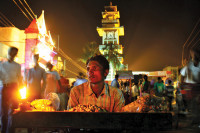Opinion
Shaken, and stirred
Earthquake-triggered landslides and the upcoming monsoon could bring more misery to hill and mountain communities
Navin Singh Khadka
All the districts hit by the April 25 quake are hilly and mountainous and very few of them had settlements with modern buildings. Most houses were traditionally built—with mud, thatch, and wood. And yet, human casualties in these villages have been very high. Officials in some of these districts say that helicopters have yet to reach some of the most remote areas, where death figures could be staggering.
Blame the mountains
So how come so many people died in these places, even where there were no buildings? Blame it on the mountains—they do exactly what buildings do during earthquakes. They unleash rocks, boulders, and mudslides that sweep away villages perched perilously on mountain slopes. And sometimes, they bury entire settlements in no time. That is exactly what happened in many villages of Gorkha.
Similar reports are coming in from Kavrepalanchok, Sindhupalchok, and Dolakha. Rasuwa faced an even worse situation—it was hit by a combination of avalanches and landslides.
Pictures are emerging on social media showing dead bodies on cliffs besides mountain trails. Take a closer look and you will see rocks and boulders scattered nearby such victims. In some cases, an entire chunk of the mountain has come down. Scientists have observed several places hit by earthquake-triggered landslides.
Major, disruptive landsliding in Nepal is limited to a zone that runs east-west, approximately parallel to the transition between the Lesser and High Himalaya, according to the landslide blog run by Professor David Petley, pro-vice chancellor at the University of East Anglia, who has been studying landslides in Nepal for the past 15 years. “This zone includes parts of the districts of Gorkha, Dhading, Nuwakot, Rasuwa, Sindhupalchok, Dolakha, Ramechhap, and Kavre,” the blog explains.
The site further reads: “We observe several large valley-blocking landslides. Most observed landslides comprise comparatively small rockfalls and debris avalanches that have a significant local impact and loss of life. A zone of relatively intense landsliding and disruption can be mapped in every valley for which cloud-free imagery is available [in the] north and northeast of Kathmandu. This zone contains numerous rockfalls and debris avalanches ...It is these small, but widespread, landslides that are likely to have probably caused the largest loss of life due to landsliding.”
Blocked by landslides
Rescue and relief workers have seen many villages that have been buried or swept away by landslides that came together with the quake. They say mudslides have also buried trails and bridges, keeping them from reaching many quake-hit areas.
“There are many such places in our district,” said Jitendra Poudel, assistant chief district officer in Gorkha. “After we received no helicopter rescue and relief in some remote areas for days, we tried reaching those places on foot but landslides have not allowed us to do so.”
Dr Robert Parker, a researcher with Cardiff University’s School of Earth and Ocean Science, who studies the occurrence of landslides after earthquakes, says it is not about few mudslides here and there. “The steep topography and high relief in the area of the epicentre, and the high intensity of shaking that was felt mean that thousands of landslides are likely to have been triggered by the earthquake,” he said in an interview I did for the BBC. “These landslides could range from a boulder fall to rock avalanches.”
But the trouble is there is no complete information on where exactly these landslides are. Cloud-free images are not yet available for all valleys in the north and north east of Kathmandu, according to Prof Petley’s blog. “Until they are [available], we must expect that similar levels of disruption are present in all valleys within the zone.”
The monsoon is coming
Scientists believe that there should be many more landslides in the earthquake-hit districts because there has been a significant number of such geological events in Tibet after the April 25 quake. It was mainly because of the landslides that the Chinese government cancelled the spring season expedition on the north face of Everest.
And now, with the monsoon on its way, experts fear that rains will further slide mountain and hill slopes that already have cracks on them because of the earthquake. “What we normally see in a mountain area that has an earthquake is that in the first heavy rainfall event after the earthquake we get a substantial number of landslides occurring,” says Petley on the blog. “Monsoon is likely to make life difficult. Nepal has significant numbers of landslides in the monsoon anyway, so the fear would be this coming wet season might be even more difficult.”
In the 1999 earthquake in Taiwan, for instance, the number of landslides doubled in the first heavy rainfall event. It was the same in case of the 2005 Kashmir earthquake; the 2008 Sichuan quake in China was even worse. Add to that the risk of a landslide dam outburst flood when rivers get blocked by landslides and the fast-rising-level of water breaks the artificial dam, sweeping everything downstream.
“The need to plan measures to mitigate landslide deaths and disruption in the forthcoming monsoon season must remain a priority,” reads Petley’s blog.
Just when the country is picking up the pieces left by the devastating quake, this is no scaremongering. It is a timely warning to minimise what seems to be an inevitable loss. The question is what do you do about it, especially when the government says it is already overwhelmed.
Khadka is a BBC journalist based in London




 16.12°C Kathmandu
16.12°C Kathmandu










